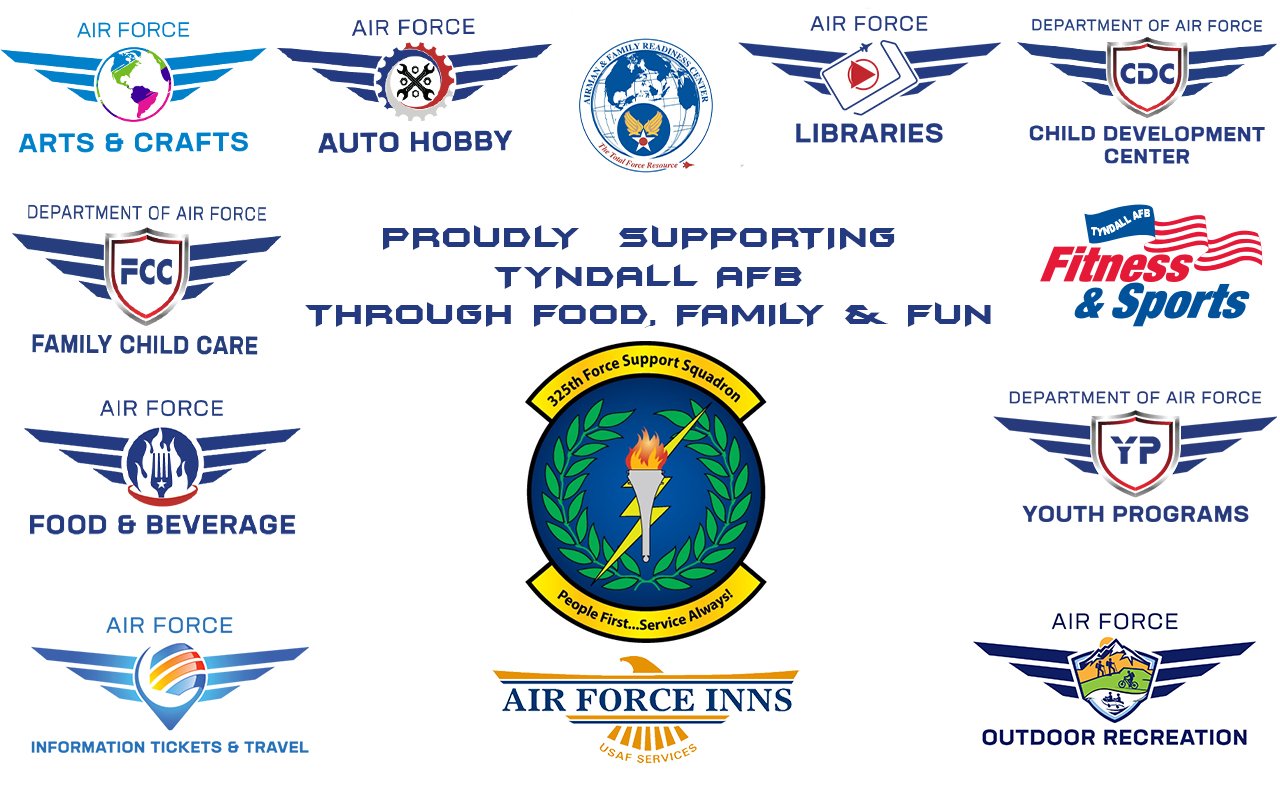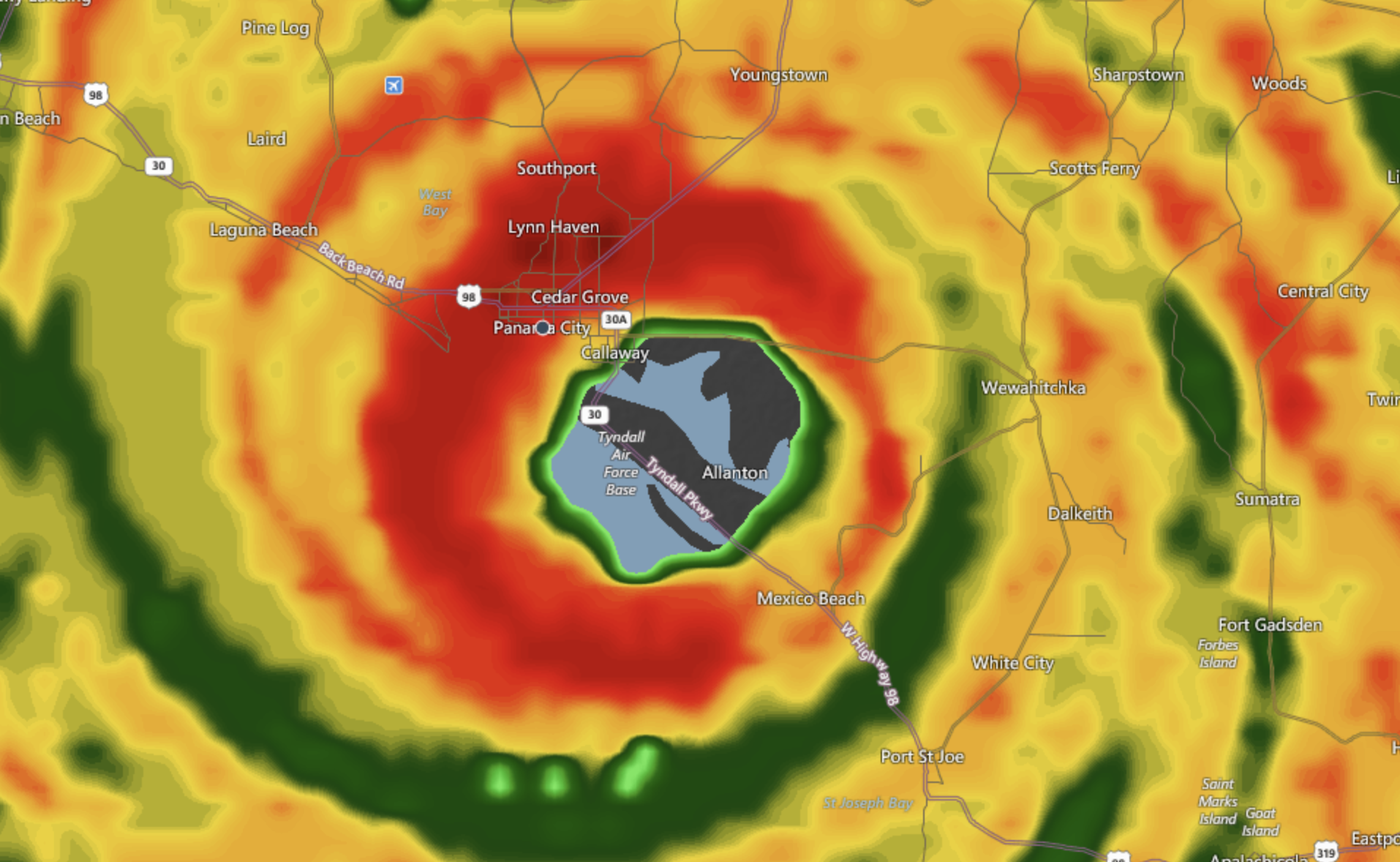
Unit Emblem
Blue and yellow are the Air Force colors. Blue alludes to the sky, the primary theater of Air Force operations. Yellow refers to the sun and the excellence required of Air Force personnel. The olive branches signify peace and peacekeeping, of the defense mission. The lightning flash represents power and readiness. The torch is a symbol of excellence and describes the attributes of strength, vigilance, spirit and camaraderie that are the center of the service mission.
Welcome to 324 FSS
The 325th Force Support Squadron provides programs vital to supporting personnel in the 325th Fighter Wing, Tyndall Project Management Office, First Air Force/AFNORTH, 53rd Weapons Evaluation Group, 823rd Red Horse Squadron Det 1, 336th Air Control Squadron, AF Civil Engineer Center, and several other national security missions, while helping to connect those personnel with the natural resources the Florida Panhandle has to offer. These Morale, Welfare and Recreation (MWR) programs offer a sense of community and improve the quality of life for our Airmen, our DoD Civilians and their families.
325 FSS Vision
Provide Unrivaled Service and Support for Team Tyndall
325 FSS Mission
Deliver!
Let the Force Support You
Mission
The 325th Force Support Squadron is one of five squadrons assigned to the 325th Mission Support Group, 325th Fighter Wing, Tyndall Air Force Base, Fla. The 325 FSS is the most widely diverse organization at Tyndall, providing more than 20 different activities to military and family members, as well as authorized civilian customers. Squadron activities generate more than $8 million annually in non-appropriated funds. The unit manages food services, lodging, personnel and manpower, recreational support, family services, youth programs, professional development and education. The squadron is also an integral part of the Aerospace Expeditionary Force with 126 members on deployment teams. The 325 FSS evolved from the Air Force-directed mergers of Tyndall’s Mission Support Squadron and Services Squadron. The merger concentrated the base’s primary customer support and service functions under one command and reduced the number of flights from twelve to five.
The Airman and Family Services Flight provides active duty members, retirees, Department of Defense civilians and their families a wide range of services: relocation, information and referral assistance; Air Force Aid; financial guidance; spouse employment, transition; and Family and Life skills. The flight provides support programs for families when the sponsor is deployed. This flight is also responsible for our Child Development Center and Youth Center, providing child development services and recreation opportunities to the families of Tyndall AFB.
The Community Support Flight provides affordable, adaptable, customer-focused and community driven programs. Additionally, the flight provides leisure-time facilities and equipment to meet the social and recreational needs of the Tyndall community. Leisure-time facilities include the Beacon Beach/Outdoor Recreation, Skills Development Center, Auto Skills Development Center, paintball and archery ranges, the base marina and FAMCAMP.
The Force Development Flight offers a variety of professional development, educational services and support to Team Tyndall members. The flight has a broad academic offering for enlisted, officers, civilians and their dependents in furthering their education. Additionally, the flight provides professional military education through the First Term Airman’s Center for Airmen for Airmen arriving at Tyndall as first duty station. The Airman’s Leadership School prepares our Airmen as they transition into the ranks of non-commissioned officers. Our Career Assistance Advisor is available to guide Airmen in choosing career paths and offers continuing professional education classes to further their knowledge, skills and abilities. The Tyndall AFB Library supports the community through by providing education, reference and reading materials for all ages.
The Manpower and Personnel Flight consists of military and civilian personnel along with manpower. The Military Personnel Section manages all personnel issues pertaining to active-duty, reserve and retired service members and their dependents. Included in this area of responsibility are: Assignments, promotions, deployment processing, reenlistments, separations, casualty assistance and military benefits. The Civilian Personnel Office provides guidance and assistance to commanders and supervisors on federal personnel rules, regulations and procedures for appropriated fund employees. The Human Resource Office provides like services for non-appropriated fund employees on Tyndall AFB. Our Manpower and Organization office is dedicated to supplying innovative management services to help the wing manage its manpower resources. In addition, this office is the focal point for the wing’s Best Practice and Air Force productivity enhancement programs.
The fifth flight, Sustainment Services Flight, provides lodging for temporary duty and transient personnel, leisure and social events and operates dining facilities for the enlisted and temporary duty personnel. The Berg-Liles Dining Facility provides hot, nutritious food service to more than 62,000 personnel annually in support of the Air Force mission. The small, but mighty, Eagle Quick Turn Flight Kitchen is provides high quality “meals on the go” for maintenance, pilots, operational personnel and support staff. The Heritage Club offers fine dining, social programs and hosts professional and personal events. The Sand Dollar Inn annually accommodates more than 26,000 guests staying 142,000 bed-nights in 550 units throughout 56 buildings. Also included in the Sustainment flight is the Tyndall Fitness Center. The center improves the quality of life and moral while preparing military personnel for deployment with a variety of excellent physical fitness, instructional, and athletic competition programs.
History
The 325 FSS was activated Nov. 3, 2008 when the former 325th Mission Support Squadron and 325th Services Squadron merged into a joint squadron. The 325th Mission Support Squadron history was a long and honorable one. First activated on June 9, 1948, at Hamilton Air Force Base, Calif., the 325th Base Services Squadron was assigned to the Air Base Group, subordinate to the 325th Fighter Wing. The wing moved to Moses Lake Air Force Base, Wash., on Nov. 26, 1948 and the 325th BSS made the move as well. The squadron was deactivated on March 10, 1950, but was reconstituted and redesignated the 325th Mission Support Squadron on Aug. 15, 1988 at Tyndall AFB, Fla., as part of the Air Force’ program to realign certain combat support group functions, and again supported the 325th Fighter Wing. The Manpower and Organization Flight was added to the squadron in October 2004 as part of a Headquarters, Air Force-directed merger between personnel and manpower. During the same time, the Career Assistance Advisor (CAA) position was repositioned to the squadron and the FTAC was realigned directly under the CAA.
Similarly, the 325th Services Squadron shared a long and honorable heritage. Its history branches from the service’s morale, welfare and recreation programs originated during the Revolutionary War when food, lodging and sale of goods by settlers provided income to post funds. Congress officially recognized military welfare and post funds in an 1861 Civil War appropriation bill. During that time, organizations such as the United States Sanitary Commission (forerunner of the American Red Cross) and religious groups were visiting troop locations and providing forms of recreation. When a huge citizen army was established during World War I, library services, troop canteens, sports programs, cultural arts programs, a motion picture service, and the United Services Organization (USO) were founded. Service clubs were begun in World War II. Since that time, these services have evolved into a growing multi-faceted leisure time program.
On Oct. 1, 1991, Tactical Air Command officially activated the 325th Morale, Welfare and the Recreation (MWR) Squadron and the 325th Services (SVS) Squadron under the 325th Support Group. Tactical Air Command was deactivated June 1, 1992, and the squadrons were activated under Air Combat Command. The 325th MWR Squadron and the 325 SVS were integrated into the 325th Morale, Welfare, Recreation and Services Squadron (MWRSS) on Oct. 1, 1992. As a result of the realignment of Air Force major commands, Tyndall became a part of the Air Education and Training Command on July 1, 1993. On Jan. 1, 1994, the 325 MWRSS was officially re-designated the 325 SVS. The 325 FSS continues to provide support to the 325th Fighter Wing by orchestrating combat support, military and civilian personnel programs, recreation and leisure activities, base education and force development, manpower and organization, family support and youth services. This unit is uniquely posed to prepare our future leaders, support their family members and coordinate actions in support of global contingencies for the 325 FW.
The Eye of the Storm
On October 10, 2018, Hurricane Michael made landfall as a Category 5 storm. Its eye passed directly over Tyndall AFB, changing the landscape of our installation. The destruction to the base and the surrounding area — Bay County and beyond — was catastrophic.
Every building on the installation suffered damage of different degrees. But it was the resiliency of the community that proved stronger than the massive winds.
We are in the process of rebuilding. We are overcoming the obstacles.



